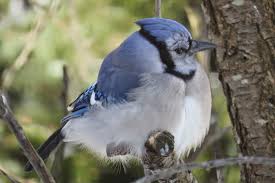
I’m now timing my walks with my dog Gage to coincide with the highest temperature of the day—or at least I try (I don’t need to explain to any local that our weather reports are probably created using a magic eight ball). Gage is “big boned,” weighing in at eighty pounds, and has a gorgeous, thick coat that I just may need to repurpose when she no longer needs it. Bears and marmots hibernate and hummingbirds migrate, but what happens to those brave birds that choose to winter here instead of Lake Havasu?
In the RMNP, over 270 species of birds have been documented. Once I got the idea for this article, I’ve been paying more attention, and I’m frankly astounded by all the different kinds of birds that are still around. But how do they manage to survive the winter? Birds aren’t exactly chunky; a large blue jay weighs 3.8 ounces and a chickadee tips the scale at just 0.44 ounces. How did their tiny, stick legs not freeze during our recent -20+ degree nights?
In reality, a bird’s legs and feet are covered in scales, not living tissue. And they have an adaption in their circulatory system where blood is circulated between colder outer areas and warmer inner areas, which is why a duck’s feet don’t turn into popsicles when they paddle the icy lakes. When roosting, birds will either stand on one leg and tuck the other in, or they crouch down and cover both legs. Birds produce more feathers in the winter, and they fluff them out to create air pockets for additional insulation. When they’re cold, they shiver to raise their metabolic rate. They also have oil producing glands which are used to coat their feathers as a waterproofer. At night, birds like crows gather in large flocks and crowd together in a small, tight space so they can share body heat.
And how do they find food? Chickadees, crows and jays have spent all fall hiding caches of berries, nuts and dead insects. These little geniuses can remember literally a thousand locations, whereas I can’t ever remember where I left my one phone. The term “bird brain” shouldn’t be an insult, it should be synonymous with Einstein. On very cold nights, a chickadee will stuff itself, adding 10% more body weight, and then go into a stupor and slowly digest the food to provide enough energy to survive until morning.
The biggest thing we can to do help our feathered friends is to put out food and water so they don’t have to use up their precious energy searching. I’ve never had bird feeders because, call me crazy, I’m not into daily bear visits. But now that the bears are busy dreaming of unlocked garbage dumpsters, I’m going to put out bird food. Try suet, which is like bird peanut butter, or seeds that are high in fat. And when you’re outside, look up and appreciate who is keeping you company this winter.
Originally published in The Boardwalk newspaper, Grand Lake, Colorado.